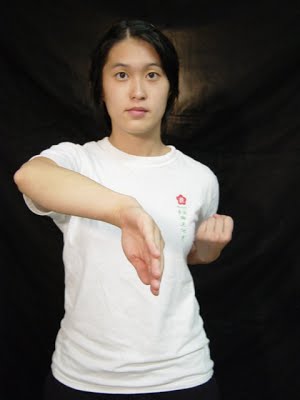By Aaron Vyvial | August 23, 2014

Taan Sao
“Palm-Up Hand”
Of the Ving Tsun hand techniques the Taan Sao is generally accepted as one of the most distinctive individual techniques in the system. It can be applied in many ways and has at least four distinctive shapes. In the end though, no matter what fancy names people come up with, whether the Taan Sao is used on the inside or outside gate or high or low it is all still Taan Sao. Which leaves the question, is Taan Sao a shape, a movement or an energy?
Taan Sao (Mid-level): The most commonly seen shape that is seen in the first section of Siu Nim Tau which extends out of the centerline ending with the elbow about a fist and a half from the chest on center with the finger tips at about chin level. This Taan Sao is used in many ways and can counter and re-direct many types of attacks to the body and face such as the straight punch, karate-reverse punch, and the boxer’s jab.
Go-Taan Sao (High): As seen in the third section of Siu Nim Tau, playing the Taan Sao raised at the shoulder bringing the entire Taan Sao structure up as a whole with the fingers still pointing (flattening the hand) at the throat of the opponent will offer more upper body and head protection at the initial contact stage.
Dai-Taan Sao (Level): Another Taan Sao shape is played level to the ground out from the body and is seen in the third section of Siu Nim Tau. It is normally used after the point of contact or after a failed attack for trapping the opponent’s hands but would not work against someone striking toward’s the head or face.
Shoulder-line Taan Sao: When redirecting incoming force the Taan Sao can be used to direct the opponent past the body as seen in second section of Chum Kiu.

Fook Sao
“Covering Hand”
The Fook Sao is generally used against attacks that come from under the hand. If the starting hand position is high then the Fook Sao can cut down into the center taking a mid-level attack off-line. There are two ways of playing a Fook Sao:
Siu Nim Tau Fook Sao: the hand comes out of center with the hand turned horizontal with the thumb on top and level to the ground. Similar to what some call a “crane fist” or a “mantis bil sao” the fingers are touching the thumb and are pulled back towards the chest allowing a stretch in the forearm which is the main purpose of this Fook Sao.
Practical Fook Sao: This covering Fook Sao with the palm down and fingers extended towards the opponent is the Fook Sao that should be used during Chi Sao and against an attack. The curled hand version that we use in Siu Nim Tao would be useless in a practical situation causing muscle tension in the bicep, which is a pulling muscle and would allow strikes to come in unless combined with a centerline shift to turn the attack away. The Practical Fook Sao will redirect an attack by using proper structure with elbow alignment so there would be no need to shift or even move the arm, the structure would do the work for you.

Bong Sao
“Wing Hand”
If used as a position, Bong Sao is one of the weakest shapes and techniques in the Ving Tsun system but if used as a transitional to change from one technique to the other then it is one of the most useful there is. There are instances though where you need to hold energy on the line with the Bong Sao in order to step, change from inside to out side gate or even to switch to the other opponent’s side. There are three levels of Bong Sao.
Bong Sao (level): Bong Sao is a one-handed technique used for deflection and as a transition to another two handed technique, it is usually considered a last-defense technique since it should only be used when the other more direct techniques have failed. If the Bong Sao is backed by a Wu Sao (protecting hand) then it is now called Quan Sao (rotating hands) allowing energy to be held on the line. Bong Sao by itself must not remain or hold energy on it’s own because the structure is inherently weak and easily collapsed. A Bong Sao is normally seen combined with Che Mah (shifting) helping redirect strong attacks away from center.
Dai Bong Sao (low): Normally combined with Taan Sao to create Quan Sao (rotating hands), Dai Bong Sao is capable of holding a large amount of energy on the line before changing to another technique.
Go Bong Sao (high): Normally confused with Biu Sao (thrusting hand) a Go Bong Sao is used to protect the head from high strikes and can be used at the initial stage of contact. It also used to redirect forceful techniques or to switch to the other side of the opponent.

